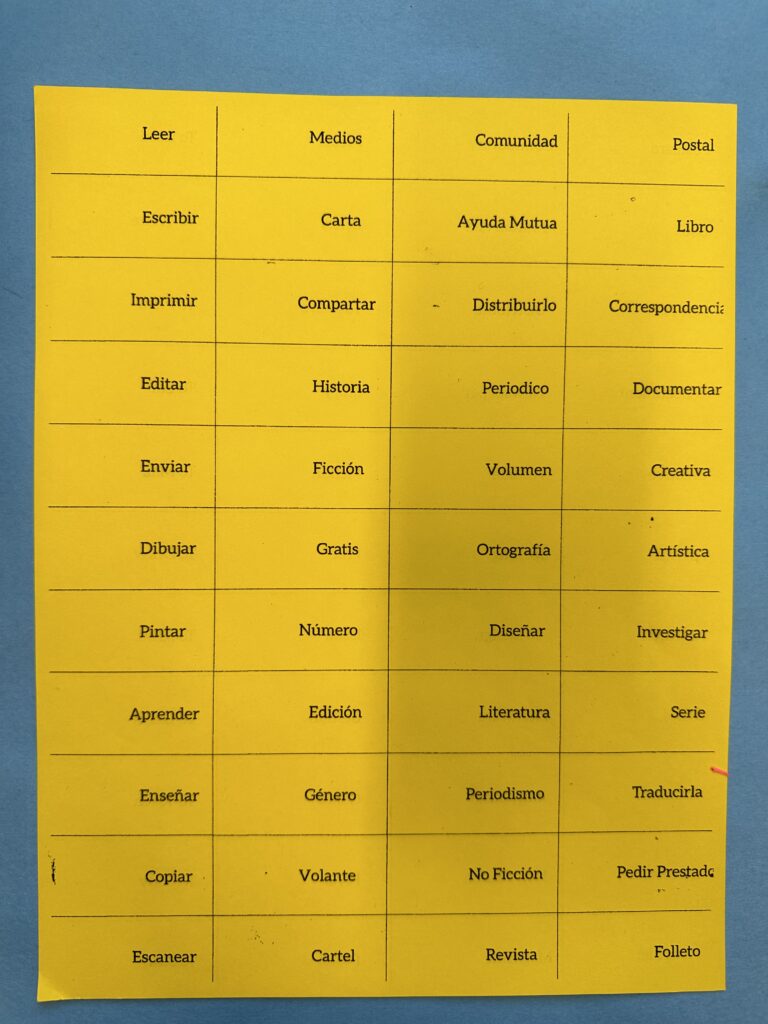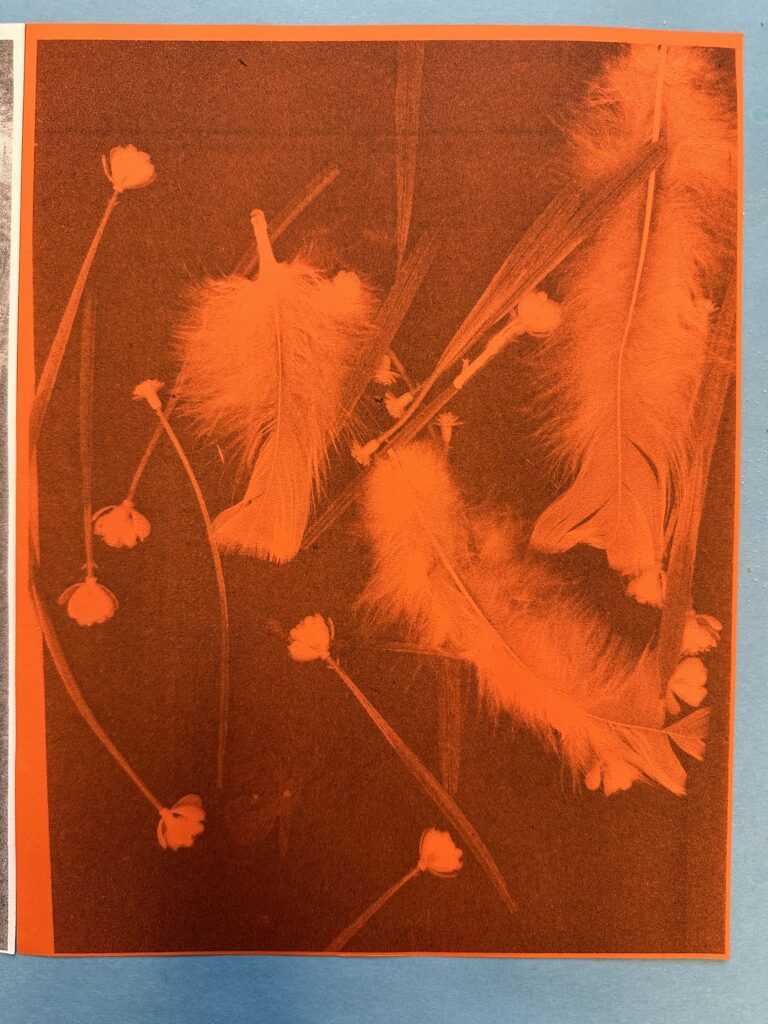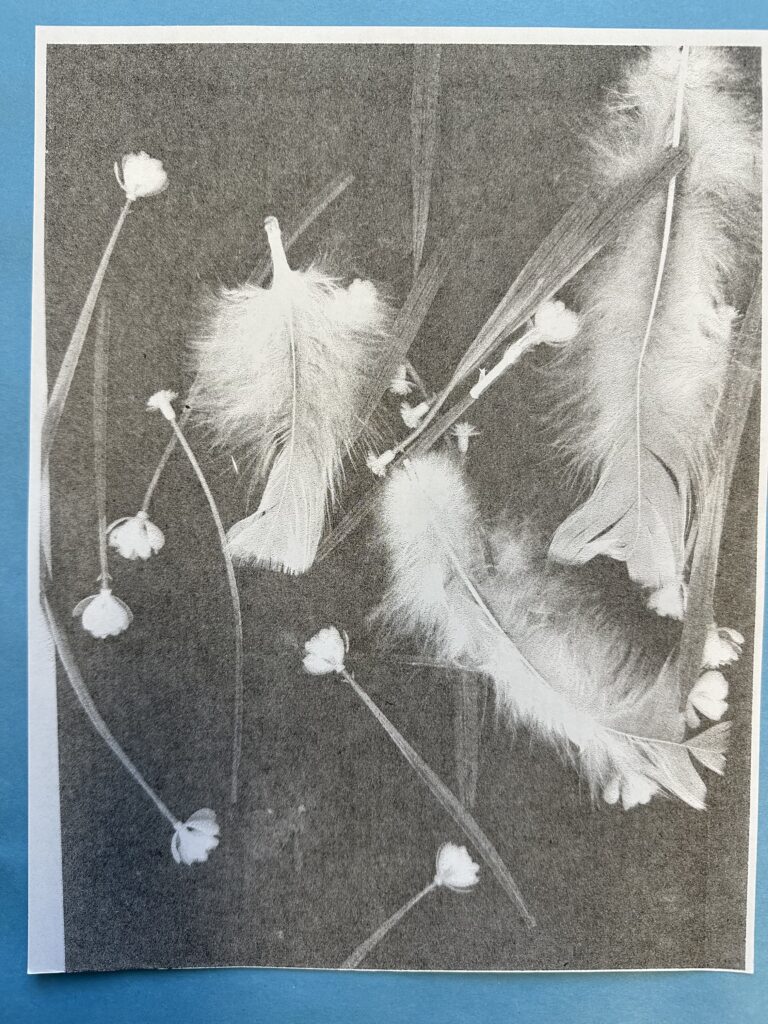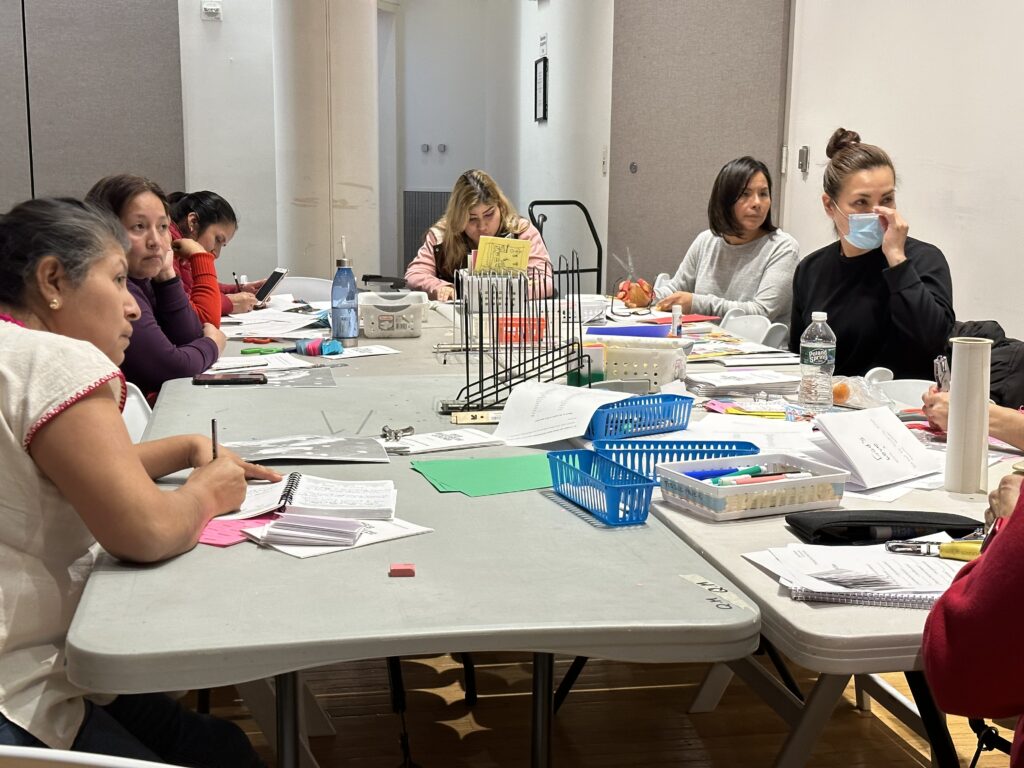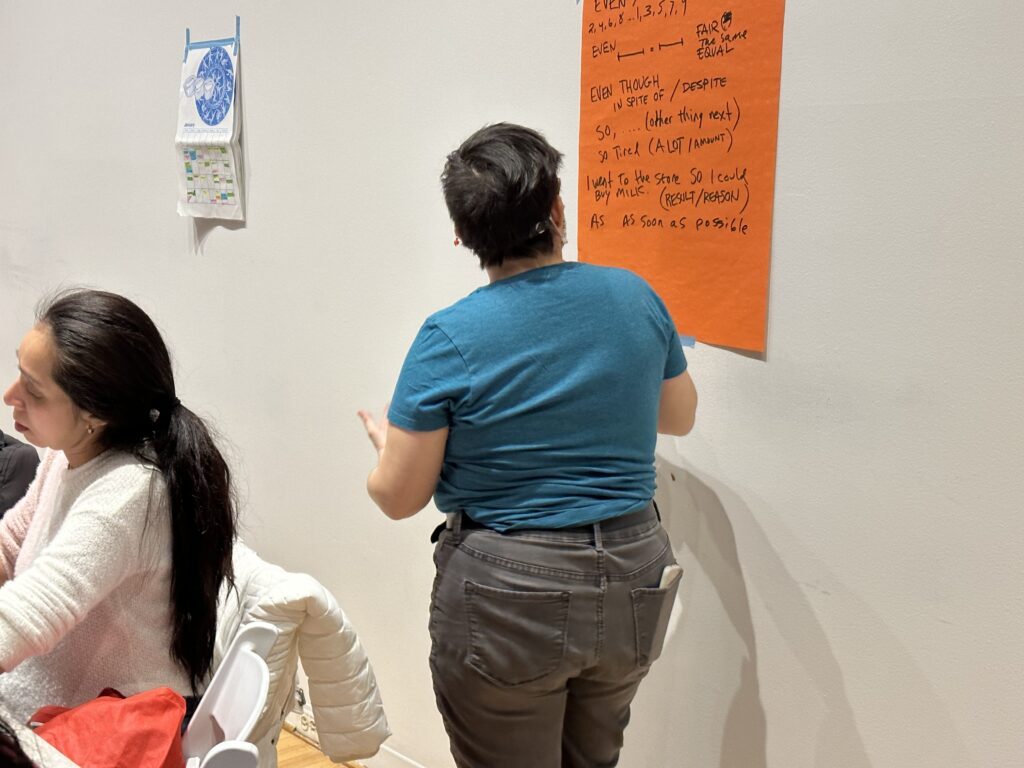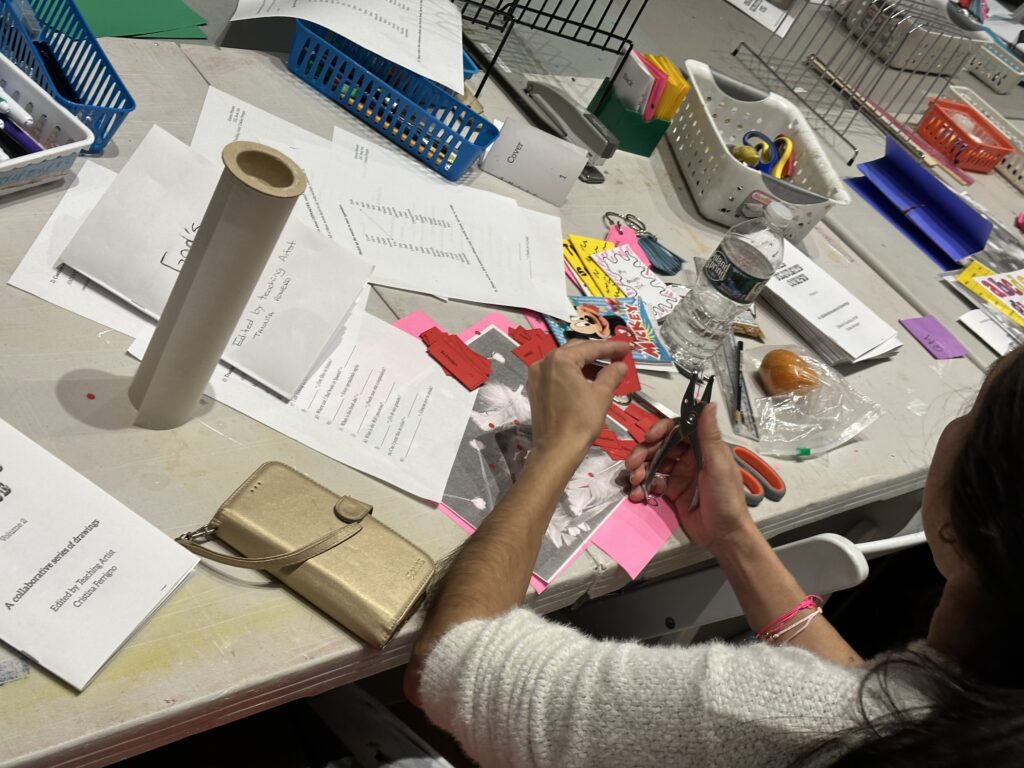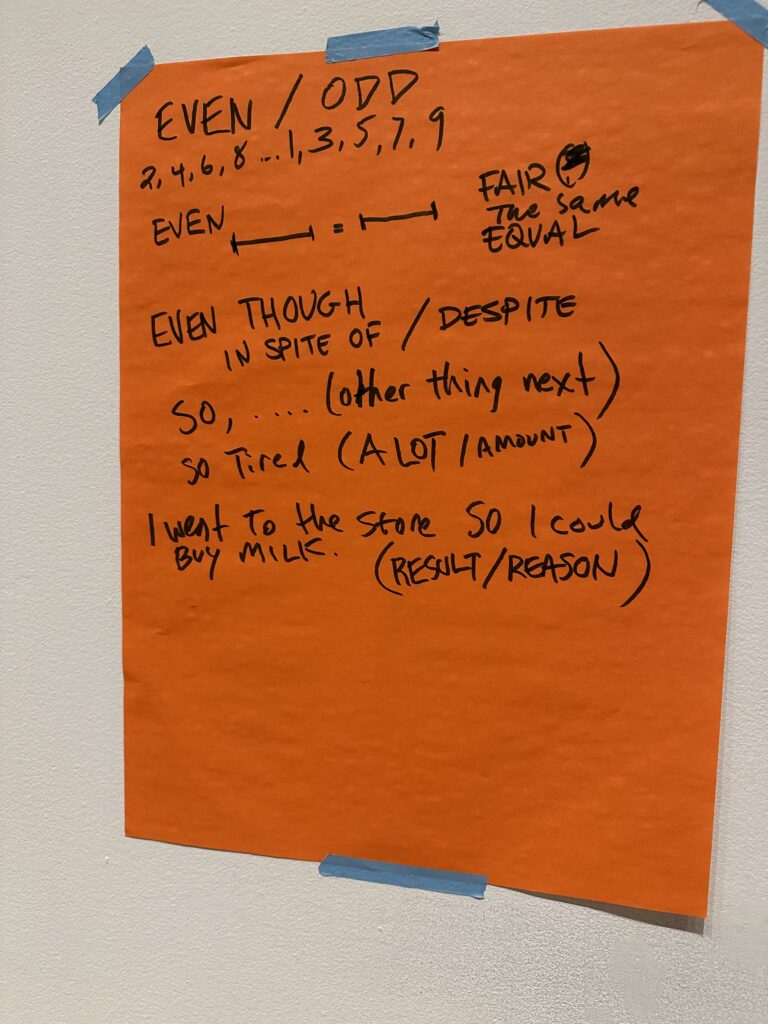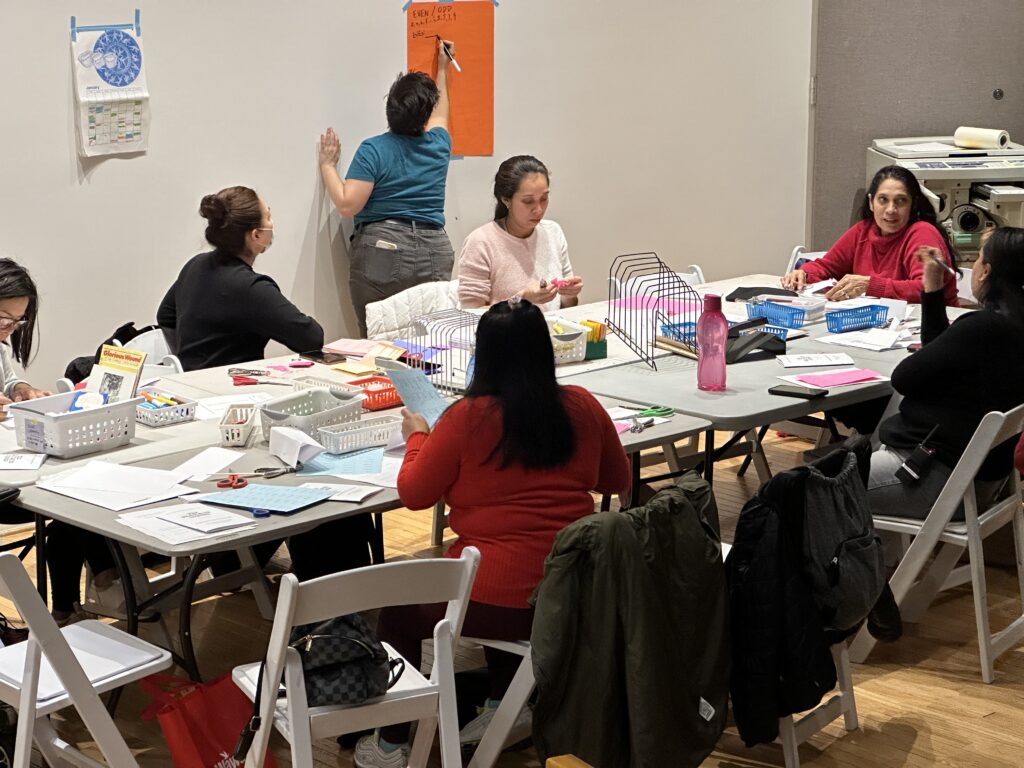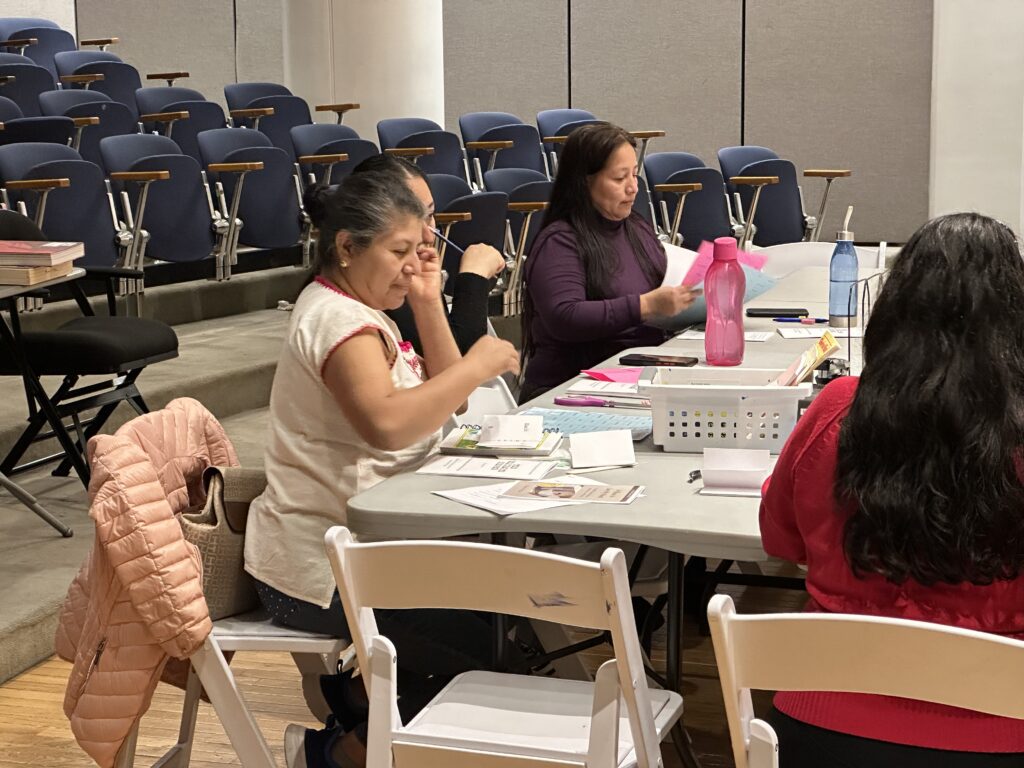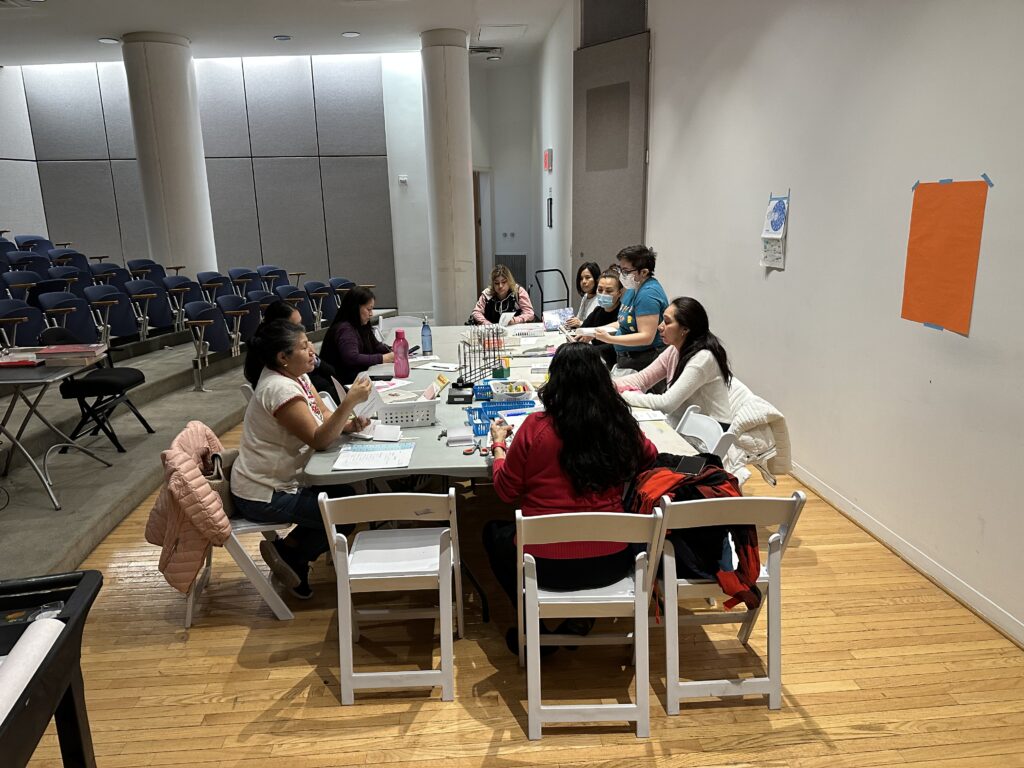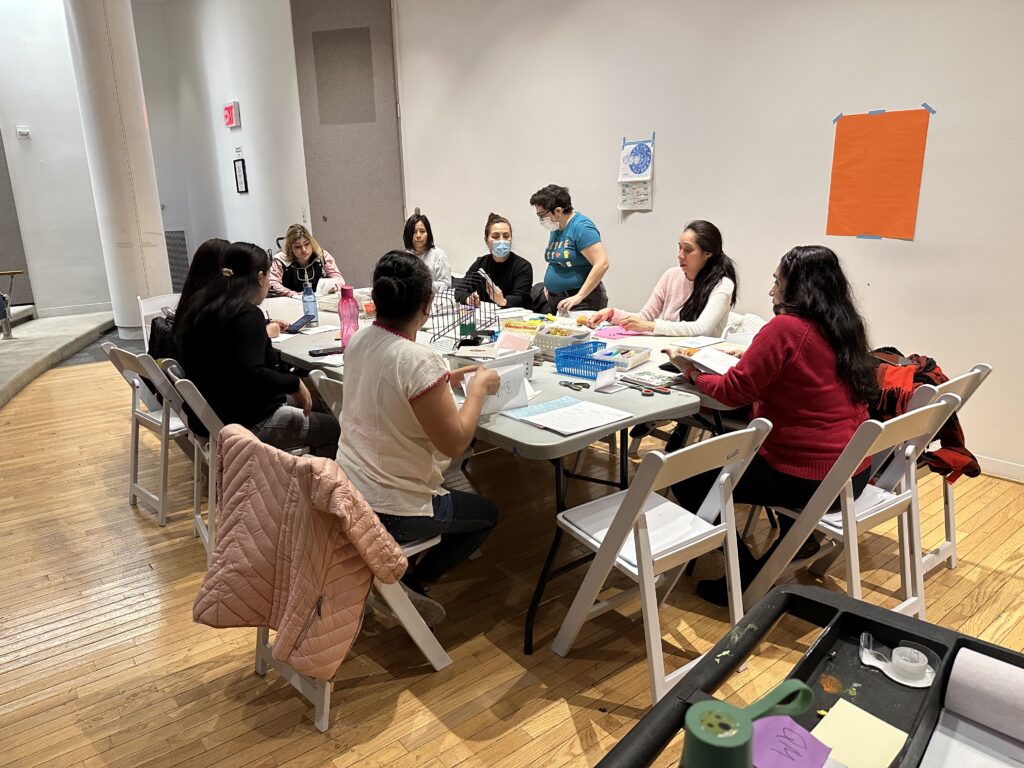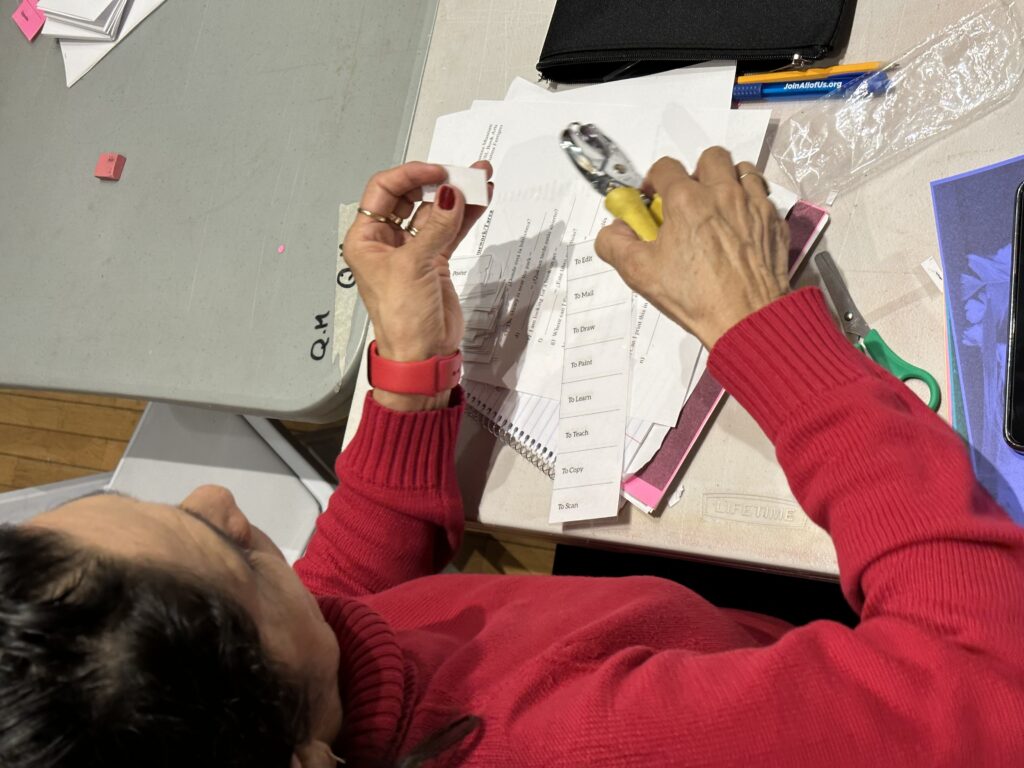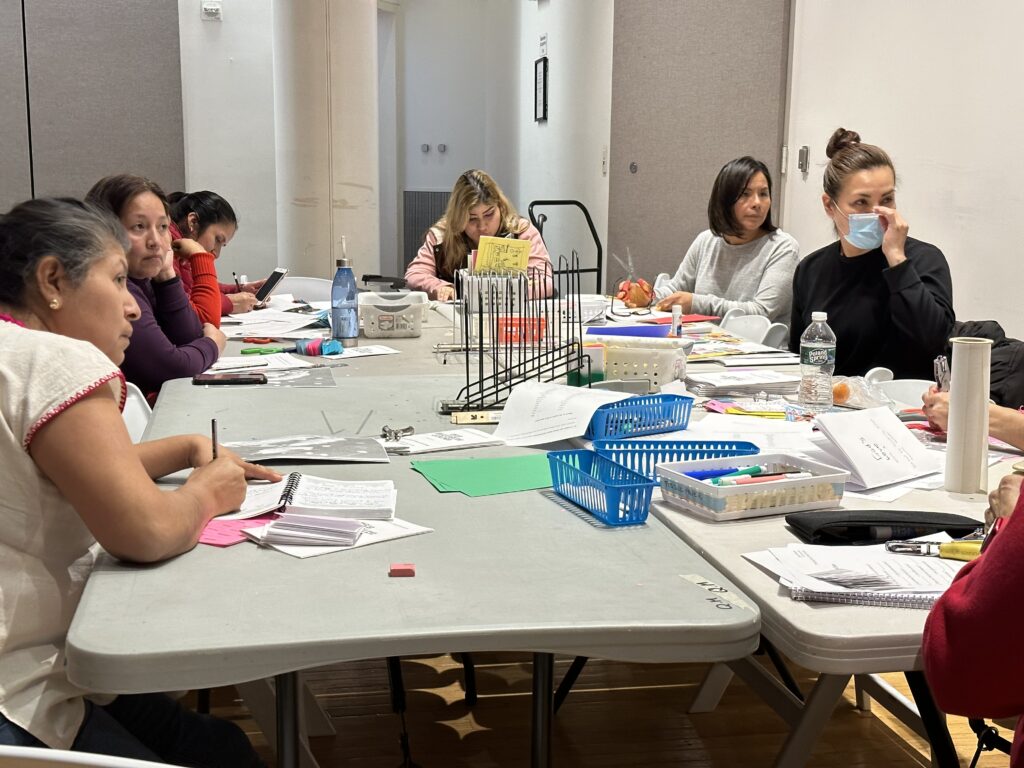
ESL Book Arts
New New Yorkers Program
Queens Museum
Teaching Artist: Cristina Ferrigno
NNY Blog Post #3
In our third class, we added to our vocabulary books with terms having to do with publishing, different kinds of writing, and the creative process. We talked about some projects we’d like to make. We also got to experiment with the risograph machine some more and made prints of objects placed on the scanning bed.
We went over some particularly tricky words in English like “So,” “As,” and “Even.”
En nuestra tercera clase, hemos ampliado nuestros libros de vocabulario con términos relacionados con la edición, los distintos tipos de escritura y el proceso creativo. Hablamos de algunos proyectos que nos gustaría hacer. También hemos experimentado un poco más con la máquina risográfica y hemos hecho impresiones de objetos colocados en el lecho de escaneado.
Repasamos algunas palabras especialmente difíciles en inglés como “So”, “As” y “Even”.
Uses of So
- “I’m so tired” here, so indicates an amount, intensity, or degree of something. “Thanks so much!”
- “So, we will continue with this course of action” in this case, so is describing a result, decision, or conclusion.
- So can also be used to transition to another topic. “So, we will move on to the next item”
- “I went to the store so I could buy milk” in this sentence, so is describing a reason. It is connecting the two ideas and giving an explanation.
- So can also be used as a substitute for “me too.” or “me as well.” For example, “I’m going to the party”–“Cool, so am I!”
Usos de So
“I’m so tired” aquí, so indica una cantidad, intensidad o grado de algo. “¡Muchas gracias!”
“So, we will continue with this course of action” en este caso, so está describiendo un resultado, decisión o conclusión.
So también puede utilizarse para pasar a otro tema. “Así que, pasaremos al siguiente tema”
“I went to the store so I could buy milk” en esta frase, so está describiendo una razón. Conecta las dos ideas y da una explicación.
So también puede utilizarse como sustituto de “me too” o “me as well”. Por ejemplo, “Voy a ir a la fiesta”–“¡Genial, yo también!”.
Uses of As
- “As soon as possible” As is used twice here, in this case it is used to emphasize the statement and add importance.
- “As beautiful as the sun” this sentence is what we call a simile. It is comparing two things but is not literal, it is more poetic or literary.
- As can be used as a conjunction, connecting or comparing two ideas “the test wasn’t as hard as I thought it would be”
- It can also describe a characteristic, feature, or history of a person or thing “She works as a teaching artist.” In this case, it describes a profession or a person’s employment.
- As can be used as an adverb (followed by an adjective, an adverb, or a word such as “much” or “many”): “Nylon is cheaper than leather, and it’s just as strong.” connecting the comparison or characteristics between things.
- It can be used for mentioning something that is already known or has already been talked about. “As I was saying, zines are a great way to get information out to your community.” It is a summary or repetition of an idea that may or may have not been interrupted by a different thought or topic.
- Describing two things happening at the same time, simultaneously “As we were sitting down to dinner, the phone rang.” “We got to the store just as they were about to close.”
- It can be used to describe a reason for something “Guido led us to the classroom, as he knew the location and which way to go.”
Usos de As
- “Tan pronto como sea posible” As se utiliza dos veces aquí, en este caso se utiliza para enfatizar la afirmación y añadir importancia.
- “Tan hermoso como el sol” esta frase es lo que llamamos un símil. Compara dos cosas pero no es literal, es más poética o literaria.
- Como puede utilizarse como conjunción, conectando o comparando dos ideas “el examen no fue tan difícil como pensaba”
- También puede describir una característica, rasgo o historia de una persona o cosa “She works as a teaching artist”. En este caso, describe una profesión o el empleo de una persona.
- As puede utilizarse como adverbio (seguido de un adjetivo, un adverbio o una palabra como “much” o “many”): “El nylon es más barato que el cuero, y es igual de resistente”, conectando la comparación o las características entre cosas.
- Puede utilizarse para mencionar algo que ya se conoce o de lo que ya se ha hablado. “Como decía, los fanzines son una forma estupenda de hacer llegar la información a tu comunidad”. Es un resumen o repetición de una idea que puede o no haber sido interrumpida por un pensamiento o tema diferente.
- Describe dos cosas que suceden al mismo tiempo, simultáneamente “Mientras nos sentábamos a cenar, sonó el teléfono”. “Llegamos a la tienda justo cuando estaban a punto de cerrar”.
- Puede usarse para describir la razón de algo “Guido nos guió hasta el aula, ya que conocía la ubicación y el camino a seguir”.
Uses of Even
- “I was on time for work, even though my train was late.” Here, even indicates a contradictory relationship between these two ideas. In this case, it can be used instead of “in spite of” or “despite.”
- “It was evenly divided” here, even is used to indicate a balance or an equal or consistent amount of something. “At halftime the scores were even”
- Even could also indicate being directly next to or adjacent to, “the ruler was even to the edge of the paper”
- Even can also be an adjective and we can use it to refer to a flat or smooth surface. “The sidewalk was even and not cracked”
- When talking about numbers, even is the opposite of odd and indicates a number that is divisible by 2. “What is the next even number after 18?”
- Even can be used to emphasize a statement, “He was too poor to even buy fresh fruit.”
Usos de Even
- “Llegué a tiempo al trabajo, aunque mi tren llegó tarde”. Aquí, even indica una relación contradictoria entre estas dos ideas. En este caso, puede usarse en lugar de “in spite of” o “despite”.
- “It was evenly divided” Aquí, even se usa para indicar un equilibrio o una cantidad igual o consistente de algo. “En el descanso los marcadores estaban igualados”
- Even también puede indicar estar directamente al lado o adyacente a, “the ruler was even to the edge of the paper”
- Even también puede ser un adjetivo y podemos usarlo para referirnos a una superficie plana o lisa. “La acera estaba lisa y sin grietas”.
- Cuando hablamos de números, par es lo contrario de impar e indica un número divisible por 2. “¿Cuál es el siguiente número par después de 18?”.
- Par puede utilizarse para enfatizar una afirmación: “Era demasiado pobre incluso para comprar fruta fresca”.
This week’s homework:
La tarea de esta semana:
Develop your idea for your final book or zine project.
Some things to think about:
- What format will it be? One-page zine, booklet, pamphlet, or poster?
- How many pages?
- Color or black & white?
- On colored paper or white paper?
- Will you use a computer or handwrite the words?
- How many do you want to make? (this is called an edition)
- Will there be a cover, a table of contents, your name, or information on when, how, and where it was made?
- Will you use images, photographs, or drawings? If yes, how will they be integrated into your project?
- Why is this subject important to you?
- What could other people learn from your project?
- How can this project be used to help you or others with learning English?
I would like you to challenge yourself and your English skills. I can help you edit and spell-check your writing before your project is finalized. Please think about making drafts and refining and editing your own work in stages versus making a whole project all at once.
There was also a homework sheet for Lesson 3 that I think you all got. If not, it is posted here.
If you have not yet joined the WhatsApp group please, contact Gia at genriquez@queensmuseum.org
Si aún no te has unido al grupo de WhatsApp, ponte en contacto con Gia en genriquez@queensmuseum.org
Our next class is Wednesday, February 22nd 10am-12pm. See you then!
Nuestra próxima clase es el miércoles 22 de febrero de 10am a 12pm. ¡Nos vemos!

